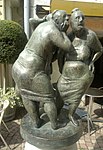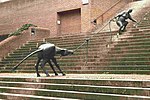Karl-Henning Seemann
Karl-Henning Seemann (born March 13, 1934 in Wismar ) is a German sculptor and draftsman, who was best known for his sculptures and fountains in public spaces .
Life
From 1953 to 1955 Seemann studied sculpture at the University of Fine and Applied Arts Berlin-Weißensee with Heinrich Drake , Heinz Worner, Theo Balden , Arno Mohr , from 1955 to 1959 he continued his studies at the University of Fine Arts Berlin-Charlottenburg with Alexander Gonda, Bernhard Heiliger and Hans Jaenisch left . In 1958 he was accepted into the German National Academic Foundation . From 1959 to 1960 he completed an art teacher exam at the State Academy of Fine Arts in Stuttgart with Christoff Schellenberger, Gerhard Gollwitzer and Rudolf Daudert and then worked as an art teacher at the Johann Sebastian Bach Grammar School in Mannheim until 1961. From 1961 to 1965 Seemann was assistant to Jürgen Weber at the chair for modeling and life drawing at the TH Braunschweig .
Seemann's artistic work was first honored in 1966 with the Rudolf Wilke Prize of the city of Braunschweig .
In 1972 he was appointed to the Aachen University of Applied Sciences and from 1974 to 1999 he was professor at the State Academy of Fine Arts in Stuttgart .
Seemann has lived and worked in Löchgau since 1975 . From July to September 2006, numerous works by Seemann were on view in a public exhibition in Möckmühl .
Works
- In Aachen , the fountain cycle of money (1977) is on the corner of Hartmannstrasse and Ursulinerstrasse. The six bronze figures on the edge of the fountain show the handling of money, the circular movement of the water stands for the constant flow of money.
- In Bietigheim-Bissingen the Schwätzweiber (1976/1977) are part of the sculpture exhibition Sculpture Bietigheim-Bissingen in the historic city center.
- On January 31, 2009, a sculpture in honor of Theodor Heuss by Horst Köhler was unveiled in Brackenheim .
- In Braunschweig-Melverode, Seemann created the crucifix and the entrance portal that depicts the life of Dietrich Bonhoeffer for the Dietrich Bonhoeffer Memorial Church, which was built from 1963 to 1066 and consecrated on Advent in 1966.
- The bronze statue of a Shoehorn, acquired in 1978, has stood in Düsseldorf's old town since 1979 .
- In Duderstadt, Seemann created the reunification fountain in 1994 as part of the state exhibition Nature in Urban Development , a symbol for the inner German wall and its fall. In 1996 the Grenzpfahlbrunnen was erected as a symbol for the division of Germany and the Cold War.
- In 1983 his three babblers were unveiled in Giessen .
- In Heilbronn , the sculpture Turning Girl stood for a long time in front of the entrance to the municipal museum in Eichgasse from 1978; it has since been moved in front of the Villa Faißt . The barrel carrier fountain from 1982 was located in the pedestrian zone until around 2000 and was a reminder of the winegrowers who were also numerous in the city center until Heilbronn was destroyed in 1944. The bronze fountain was moved to the Wein-Panorama-Weg below the Wartberg Tower in 2006, where it was presumably sawed off or broken off and stolen by metal thieves in 2018 . In the Heilbronn district of Kirchhausen , the Nepomuk fountain was built as a new village fountain in 1994/1995 and reminds of the local bond with St. John of Nepomuk , to whom a statue of Nepomuk was erected in honor as early as 1758 .
- The sculpture Woman with a Bag from 1981 is located in Lauffen am Neckar .
- In Karlsruhe in 1985 created seaman on the occasion of the 150th anniversary of Karlsruher Lebensversicherung AG the lamb or fountain at the corner of lamb and Kaiserstr.
- In 2005, a sculpture in honor of the city's founder Adolf IV von Schauenburg and Holstein was erected in the monastery garden in Kiel . It symbolizes the change from knight to monk.
- In the artist's place of residence, in Löchgau , there are several fountains and sculptures he created: a crucifixion group with Mary and Peter in front of the west gable of St. Peter's Church (second cast, original on the tabernacle of St. Peter's Church in Aachen), the town hall fountain and the sculpture The wine scandal on the town hall square, the Lörracher Reiter and the Reinecke Fuchs sculpture at the exit to Besigheim as well as the staircase sculpture in the Bürgergarten (second cast, original in front of the district office in Schwäbisch Hall) and the Hasenropferbrunnen .
- The group of figures "Copernicus Group with Martin Luther", which was created around 1978–1980, is located in Niederkassel .
- In Nordheim , the Glockenstupferbrunnen from 2001 focuses on an episode from the War of the Polish Succession in the 18th century, when the people of Nordheim sank their bell in the Neckar and (unsuccessfully) poked ("poked") for it after the war.
- In Schwäbisch Hall at the Landratsamt you can see Seemann's husband with a beer bottle , as well as an untitled group of figures who try to pull stubborn animals (Gaul and Geiß) up a mountain by ropes (both sculptures from 1981).
- In Troisdorf there is the Fat Man statue in the city center.
- Another group of figures is in front of the Palais Thermal in Bad Wildbad.
- In Braunschweig , Düsseldorf , Stuttgart and Tübingen there is a two-part bronze sculpture that is reminiscent of an argument (1975–1976) between a Gôg and a professor in a Gôgen joke .
Chatterbox women ,
sculpture Bietigheim-Bissingen"Heuss-Plastik" made of bronze in front of the Theodor-Heuss-Museum
BrackenheimConfrontation in
1979 in the Lammhof
Tübingen"Reunification Fountain", 1996
DuderstadtBorder guards , 2017
DuderstadtFigure group (detail) Schwäbisch Hall
literature
- Peter Grau (illustration); Dieter Groß (illustration); Karl-Henning Seemann (illustration): Peter Grau, Dieter Gross, Karl-Henning Seemann. Gallery of the City of Esslingen am Neckar, Villa Merkel, March 11 to April 10, 1983 , Stuttgart 1983.
- Oliver Kornhoff (editor): Karl-Henning Seemann - Gaining freedom from attachment. The works from 1998 to 2008 , Lindenberg im Allgäu 2009.
- Karl-Henning Seemann: sculptures and drawings , [without location, after 1977].
- Karl-Henning Seemann; Edgar Hertlein (collaboration): sculptor and draftsman 1984 , Stuttgart 1984.
- Karl-Henning Seemann: Newer sculptures 1984–1986 , Bietigheim-Bissingen 1986.
- Karl-Henning Seemann: Stuttgart Art Academy, class Prof. Seemann. [Karl-Henning Seemann… Gisela List; from September 20 to October 5, 1986 in the old post office in Eislingen] , Eislingen [approx. 1986].
- Karl-Henning Seemann: Wilhelm Rösch - an appreciation . In: Paul Sauer; Eduard Theiner; Heinz Pfizenmayer; Karl-Henning Seemann: Remsecker Lebensbilder , Remseck 1991, page 79, 83.
- Karl-Henning Seemann (editor); Helmut Gruber-Ballehr (collaboration): Spannungen , Bietigheim-Bissingen 1991.
- Karl-Henning Seemann: Art Academy Stuttgart, class Seemann, zoo drawings. [State Academy of Fine Arts Stuttgart, class for general artistic training, focus on sculpture, Professor Karl-Henning Seemann] , [Stuttgart circa 1992].
- Karl-Henning Seemann (editor): Karl-Henning Seemann 1990–1992 , Bietigheim-Bissingen 1993.
- Karl-Henning Seemann (editor); Herbert Eichhorn (collaboration): Karl-Henning Seemann - sculptor and draftsman 1992–1998 , Cologne 1999.
- Karl-Henning Seemann; Helmut Gruber-Ballehr (collaboration): Figurfontainen , Bietigheim-Bissingen 2001.
Web links
Individual evidence
- ↑ Hans Maes, Alfons Houben et al: Düsseldorf in stone and bronze. Triltsch Verlag, Düsseldorf, 2nd edition, 1984, ISBN 3-7998-0018-2 , p. 22.
- ↑ a b Carsten Friese: Second bronze sculpture stolen on the Wartberg. In: Heilbronner Voice , May 9, 2018
- ↑ Franziska Feinäugle: Naked bronze man watches over Heilbronn. In: Heilbronner Voice , July 17, 2006
- ↑ Information on the sculpture Confrontation on the artist's website: http://www.karl-henning-seemann.de/con_werkverzeichnis_detail.php?menue=2&id=26 accessed on September 29, 2014
| personal data | |
|---|---|
| SURNAME | Seemann, Karl-Henning |
| BRIEF DESCRIPTION | German sculptor and draftsman |
| DATE OF BIRTH | March 13, 1934 |
| PLACE OF BIRTH | Wismar |








